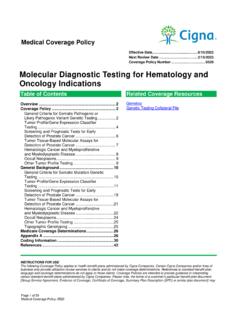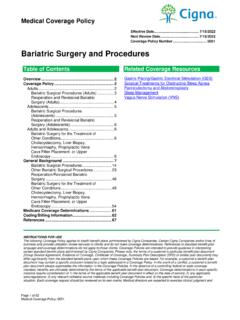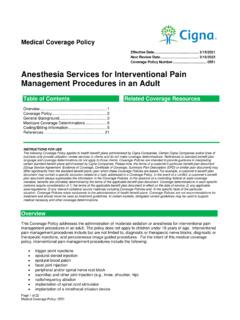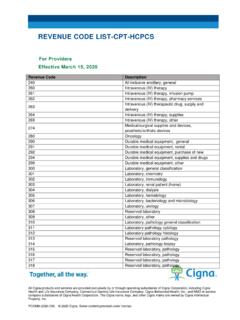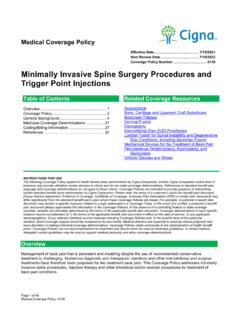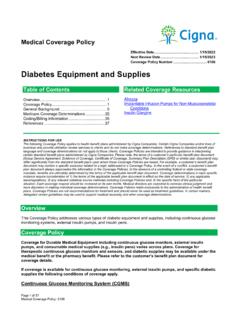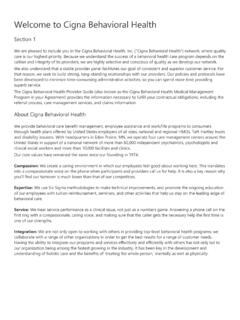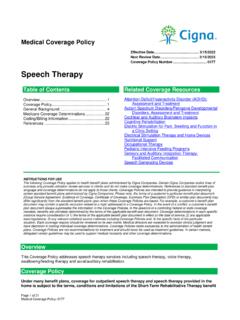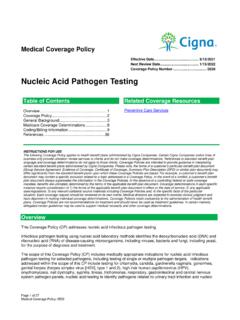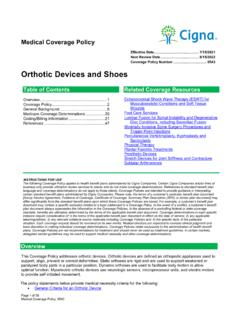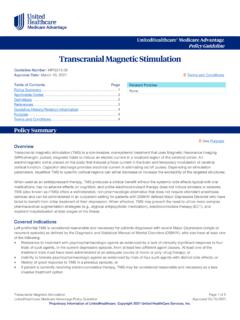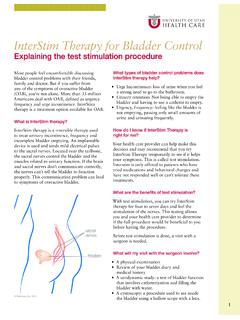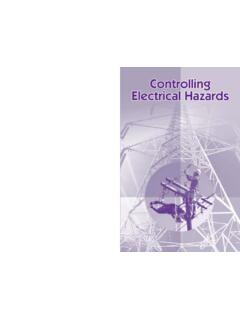Transcription of Transcranial Magnetic Stimulation
1 Medical Coverage Policy Effective 3/15/2021. Next Review Date .. 3/15/2022. Coverage Policy Number .. 0383. Transcranial Magnetic Stimulation Table of Contents Related Coverage Resources Overview .. 1 Attention-Deficit/Hyperactivity Disorder (ADHD): Coverage Assessment and Treatment General Background ..2 Complementary and Alternative Medicine Medicare Coverage Determinations ..21 Deep Brain, Motor Cortex and Responsive Cortical Coding/Billing Information ..21 Stimulation References ..22 Electrical Stimulation Therapy and Home Devices Vagus Nerve Stimulation (VNS). INSTRUCTIONS FOR USE. The following Coverage Policy applies to health benefit plans administered by Cigna Companies. Certain Cigna Companies and/or lines of business only provide utilization review services to clients and do not make coverage determinations. References to standard benefit plan language and coverage determinations do not apply to those clients. Coverage Policies are intended to provide guidance in interpreting certain standard benefit plans administered by Cigna Companies.
2 Please note, the terms of a customer's particular benefit plan document [Group Service Agreement, Evidence of Coverage, Certificate of Coverage, Summary Plan Description (SPD) or similar plan document] may differ significantly from the standard benefit plans upon which these Coverage Policies are based. For example, a customer's benefit plan document may contain a specific exclusion related to a topic addressed in a Coverage Policy. In the event of a conflict, a customer's benefit plan document always supersedes the information in the Coverage Policies. In the absence of a controlling federal or state coverage mandate, benefits are ultimately determined by the terms of the applicable benefit plan document. Coverage determinations in each specific instance require consideration of 1) the terms of the applicable benefit plan document in effect on the date of service; 2) any applicable laws/regulations; 3) any relevant collateral source materials including Coverage Policies and; 4) the specific facts of the particular situation.
3 Coverage Policies relate exclusively to the administration of health benefit plans. Coverage Policies are not recommendations for treatment and should never be used as treatment guidelines. In certain markets, delegated vendor guidelines may be used to support medical necessity and other coverage determinations. Overview This Coverage Policy addresses the various types of Transcranial Magnetic Stimulation (TMS) for the treatment of unipolar major depressive disorder and other psychiatric and neurological conditions. Coverage Policy An initial regimen ( 30-36 treatments) of Transcranial Magnetic Stimulation administered in an outpatient office setting using a Food and Drug Administration (FDA) approved device is considered medically necessary when an individual meets ALL of the following criteria: age 18 years or older diagnosis of major depressive disorder (unipolar), moderate-to-severe, single or recurrent episode or acute relapse, without psychosis, as defined by the most recent edition of Diagnostic and Statistical Manual of Mental Disorders during the current episode of depression ALL of the following criteria are met: failure of two or more trials of antidepressant medications from two separate classes of antidepressant medications.
4 A failed trial is defined as: Page 1 of 47. Medical Coverage Policy: 0383. o use of an antidepressant medication, at adequate therapeutic doses for at least four weeks with no significant reduction in depressive symptoms o use of an antidepressant medication with documented intolerance/medical contraindication an adequate trial of an evidence-based psychotherapy known to be effective in the treatment of major depressive disorder, without significant improvement in depressive symptoms validated depression monitoring scales are administered at the beginning and at the end of the initial and each subsequent course of TMS. Repeat Transcranial Magnetic Stimulation (TMS) ( 30-36 treatments) administered in an outpatient office setting for a recurrence or an acute relapse of major depressive disorder is considered medically necessary when ALL of the following criteria are met: all of the above criteria for initial TMS therapy were met prior to the initial course of TMS. individual had more than a 50% improvement as evidenced by one or more standard rating scales for depression improvement has been maintained for at least two months after initial course of TMS.
5 Transcranial Magnetic Stimulation (TMS) for any other indication, including but not limited to migraine headaches or as a maintenance therapy, is considered experimental, investigational or unproven. General Background Transcranial Magnetic Stimulation (TMS) for Depression Transcranial Magnetic Stimulation (TMS) is a non-invasive neurostimulation technique that modulates cortical excitability. In repetitive TMS (rTMS), trains of several pulses are delivered through repeated Stimulation over the same area with frequencies ranging from 1 to 20 Hz. The two most commonly used methods of TMS are repetitive Transcranial Magnetic Stimulation (rTMS) and deep TMS (dTMS). Standard repetitive Transcranial Magnetic Stimulation (rTMS) delivers a Magnetic field to a maximal depth of approximately two centimeters (cm). below the cortical surface and is also called surface cortical TMS or superficial TMS. Surface cortical rTMS of the left dorsolateral prefrontal cortex (DLPFC) is the most widely used and studied form of TMS.
6 The site most commonly used for the treatment of depression is the left prefrontal cortex. TMS is typically applied to the skull with an electromagnetic coil called a figure-of-eight coil (8-coil) ( Food and Drug Administration [FDA], Aug 14, 2018; Feffer, et al., 2017). Deep Transcranial (dTMS) stimulates brain structures beneath the superficial prefrontal cortex using a Magnetic Hesel-coil (H-coil). The H-coil is proposed to cause cortical excitability up to a maximum depth of six centimeters which causes modulation of the activity of the cerebral cortex and of deeper neural circuits making it more effective than surface Stimulation . H-coils stimulate a larger area of the brain than the conventional figure-8 coils. There are 14 different H-coils designed to target specific brain regions ( , H1, H2, H1L) based on the area and method of Stimulation . In H-coil therapy, the electromagnetic coil is contained in a helmet with multiple windings in multiple planes. Although deep Stimulation can also be accomplished with a large circular coil or a double cone coil, their electromagnetic field decays more rapidly and to reach significantly deep targets much higher intensities must be used on the surface.
7 Reported side effects include headaches, facial pain, tooth pain, neck pain and seizure (Holtzheimer, 2020; Feffer, et al., 2017; Tendler, et al., 2017; Feifel, et al., 2016; Nordenskjold, et al., 2016; Tendler, et al., 2016; Bersani, et al. 2013). The effects of TMS depend on the parameters of waveform, frequency, intensity, and duration of Stimulation . Due to the lower energy requirements, a biphasic waveform is frequently used in Stimulation . Frequency is one of the most important parameters in rTMS protocols that affect the clinical outcome. High-frequency (HF) rTMS. usually comprises frequencies 5 Hz, while low frequency (LF) rTMS includes frequencies 1 Hz. Evidence has suggested that LF-rTMS is inhibitory'' while HF-rTMS is excitatory (Guo, et al., 2017). The electromagnetic current repeatedly switches on and off for up to 10 times per second to produce the pulses. To determine the therapeutic Magnetic strength, the amount of Magnetic energy is adjusted until the motor threshold is reached Page 2 of 47.
8 Medical Coverage Policy: 0383. ( , the patient's fingers or hands start to twitch). The pulses are proposed to induce electric currents to depolarize neurons in a focal area of the surface cortex and alter brain activity in areas responsible for mood. rTMS is less invasive than vagal nerve Stimulation and is not intended to induce seizures like electroconvulsive therapy (ECT). rTMS may cause some short-term side effects such as headache, tingling of facial muscles, scalp discomfort, lightheadedness, or discomfort from the noise that the device makes. Hearing loss and seizures have been reported as uncommon side effects. Symptom relief may not take place for several weeks (Holtzheimer, 2020; Guo, et al., 2017; Allan, et al., 2011). Initial rTMS is a treatment option for a patient who is age 18 years or older and has a diagnosis of unipolar, depressive disorder, moderate-to-severe, single or recurrent episode or acute relapse, without psychosis, as defined by the most recent edition of the Diagnostic and Statistical Manual (DSM) of Mental Disorders.
9 Potential TMS candidates are those patients who have failed at least two trials of antidepressant medications, at adequate therapeutic doses, including at least two different classes for a period of at least four weeks. The regimen should have included one or more anti-depressant medications. Antidepressant classes include: selective serotonin reuptake inhibitors (SSRIs; , sertraline, fluoxetine), serotonin-norepinephrine reuptake inhibitors (SNRIs; , desvenlafaxine, duloxetine), tricyclic antidepressants (TCAs; , amitriptyline, nortriptyline, desipramine) and monoamine oxidase inhibitors (MAOIs; , isocarboxazid, phenelzine), and may be given in combination regimens. Following pharmacotherapy, TMS candidates are those who demonstrate no significant reduction in depressive symptoms which is documented by results of validated depression monitoring scales ( , Patient Health Questionnaire [PHQ-9], Beck Depression Inventory [BDI], Hamilton Depression Rating Scale [HAM-D], Montgomery-Asberg Depression Rating Scale [MADRS], Quick Inventory of Depressive Symptomatology Self- reported [QIDS], Inventory of Depressive Symptomatology Clinician-rated [IDS-SR score]).
10 Adherence to the medication should be documented or it should be documented if the patient has intolerance to the medication or could not take the medication due to medical contraindications (Thase and Connolly, 2020; Institute for Clinical Systems Improvement [ICSI], 2016; FDA, 2014). A major depressive episode as defined in the DSM-5 implies a prominent and relatively persistent ( , nearly every day for at least two weeks) depressed or dysphoric mood that represents a change from previous functioning, and includes at least five of the following nine symptoms, one of which is either of the first two symptoms (Institute for Clinical Systems Improvement [ICSI], 2016; Neuronetics, Inc., 2015): Depressed mood Markedly diminished interest or pleasure in usual activities Significant change in weight and/or appetite Insomnia or hypersomnia Psychomotor agitation or retardation Fatigue or loss of energy Feelings of worthlessness or excessive or inappropriate guilt Slowed thinking or impaired concentration Recurrent thoughts of death or suicidal ideation or a suicide attempt Standard treatments for major depressive disorder (MDD) include psychotherapy, pharmacotherapy, and/or electroconvulsive therapy (ECT).
